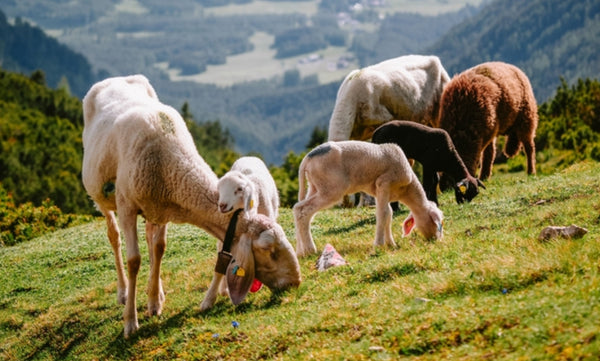Know Your Fiber: Bergschaf Wool
Posted on February 01 2025

Since pre-history, sheep have been in the Alps. In Austria and Germany, these sheep are generally covered by the blanket term Bergschaf, which means mountain sheep in German. There is a rich history of shepherding in the Alps, with landrace breeds eventually becoming established breeds such as the Tiroler Bergschaf, Braunes Bergschaf, and Schwarzbraunes Bergschaf.
The Alps sweep through a number of European countries – Austria, Germany, France, Switzerland, Italy, Liechtenstein, Monaco, and Slovenia – and the landscape has been shaped by millennia of shepherding. As flocks grazed, migrating between valleys and mountains, they shaped the ecology of the area. The shepherds have influenced the landscape over time as well; prehistoric stone enclosures are found in some of the same areas that modern shepherd huts exist. Even the tree lines of the Alps were shaped by sheep, as flocks nibbling on branches and leaves controlled the spread of the forests. When shepherding began to decline in the 1900s, the tree line started moving to a lower elevation. Recognizing how important sheep are to keep the ecosystem of the Alps in balance, several European organizations now ensure that sheep are brought to specific areas to help support local ecosystems.
There is archaeological evidence that transhumance, the practice of seasonally moving livestock from the valleys to higher elevations and back again, has been practiced in the Alps for around 6000 years. Much farming in the Alps was centered around transhumance. In the spring and fall, shepherds would walk through villages, blowing a horn to gather livestock from farmers in the morning and return them in the afternoon. In summer, shepherds would take the flocks to the high pastures for months, only returning the flocks to the farmers in the fall. While in the mountains, they would depend upon their livestock guardian dogs to help protect the sheep from wolves, bears, and lynx. Sheep were valuable, and livestock were among the most valuable things a farmer could own – shepherds managed the safety of these flocks until they were returned to their owners.
Social changes driven by industrialization, international trade, and the upheavals of World War I and World War II meant there was a steep decline in shepherding and transhumance during the 1900s. However, it left a lasting mark on Alpine culture. Today, more than 30 cheeses made exclusively in the Alps remain popular – several of them from sheep’s milk. Much like the terroir of wines, the flavor of these cheeses depends on the location of where the sheep have grazed and the place the cheeses were made. Cheesemaking is still so significant that Austria’s KäseStrasse Bregenzerwald (Bregenz Forest Cheese Trail) invites hikers to follow the long trail and experience the cheeses of the Alps.
Shepherding and transhumance in the Alps also gave rise to customs such as yodeling and to instruments such as the Alphorn, both used to call flocks and herds as well as to communicate across long distances. Seasonal festivals after the shepherds returned from the high pastures would also feature sports such as Schwingen, a type of wrestling that has become a national sport in Switzerland. Folklore about dwarves that populate the pastures of the Alps also abound. These creatures could be helpful, but sometimes they were also mischievous. Most often, they were troublesome when dealing with cruel or rude Senn – the shepherd or farmer that oversees a dairy herd.
As shepherding declined in the Alps, so did the Bergschaf populations. The Tiroler Bergschaf, the Bergschaf breed most common in Austria and Italy, became almost extinct after World War I. Thanks to the concerted efforts of shepherds and breeders, their numbers recovered, reaching about 19,000 in Austria and 13,000 in Italy today. Other Bergschaf breeds have also been developed from the landrace breeds of the Alps, such as the Braunes Bergschaf and Schwarzbraunes Bergschaf (known as Juraschaf in Italy).
Bergschaf wool comes in a range of natural colors, including white, gray, and dark brown. At 33-36 microns, it is a medium-coarse wool with a nice crimp and a relatively short staple length of 2–3 inches. This short staple felts quickly and firmly, making Bergschaf a favorite for felters, and its durability also makes it a popular choice for making felted slippers and woolen shoes. Although it can be spun, some spinners find the short staple length to be a bit of a challenge.
Why not try Bergschaf wool for your next project? We carry it seasonally, so be sure to get it while it is available!


Follow US